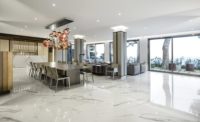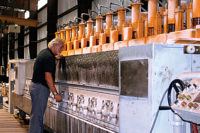These days, it seems bigger is better. Tile formats – for both tile and stone – continue to increase, as well as the size of slabs. The inherent beauty of natural stone with the diversity of color and veining allows it to be used as a work of art for an interior accent wall or provide a luxurious island countertop in a kitchen or outdoor barbecue area. Moreover, porcelain and quartz slabs for countertops and wall cladding continue to gain momentum in design. These materials are often sought after for their consistency in color and durability. “The emergence of larger slabs provides options for larger islands and less seams, which certainly is a selling point,” said Nate Steinheimer, vice president of marketing and business development at UGM Surfaces.
When it comes to fabrication, Steinheimer explains there are a host of differences in how porcelain slabs are cut compared to natural stone. “Typically, porcelain slabs require relief cuts to release tension which exists within the slab,” he said. “Additionally, most porcelain slabs require a specific type of blade, and the speed at which the material is cut slower than most natural stone or quartz. Also, the porcelain slabs which are available in the market today are not through-vein material, so the edges require mitering, whereas the edges of thicker natural stone slabs can simply be polished or profiled and require less labor.”
When asked about trends he is seeing with slabs, Steinheimer explained he believes kitchen islands appear to be getting larger in many residential homes because the availability of these larger engineered slabs seems to be supporting this trend. “These larger slabs -- especially super jumbo-sized quartz slabs -- generally seem to provide fabricators with an additional ‘run’ of material and reduces the amount of waste for larger projects.”
According to Steinheimer, the Midwest is still largely a 3cm market, and therefore, many fabricators are averse to cutting thinner material like porcelain for horizontal surfaces (which require mitering). “Porcelain slabs are a great solution for flooring, walls, tub surrounds, etc., which are less expensive and easier to install however, and we have seen increased interest and demand for these types of applications,” he said.
UGM Surfaces is not the only company seeing a rise in the demand for large slabs. On the manufacturing side, Atlas Concorde has recently committed to a new factory for the production of porcelain slabs.
“We made a big investment this year,” said Nicholas Goodman, projects division manager at Atlas Concorde USA, Inc. “It’s a growing trend in the U.S.” Sharing Steinheimer’s thoughts, Goodman cited one reason they are being favored is for less grout lines.



